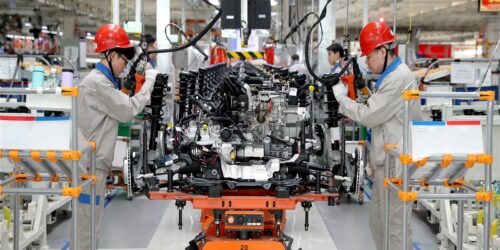Progress Report – Future of Work and Its Effects on the Canadian Manufacturing Sector

Future of Work and Its Effects on the Canadian Manufacturing Sector
Abstract: Manufacturing sector in Canada is often seen as a cornerstone of the national economy. Currently, Canadian manufacturing firms are facing significant challenges to adapt themselves to every day evolvement in technology and modernisation, and workers in the sector, on the other hand, are feeling the fear of leaving their jobs to machines and robots every day, while advances in modern technology including industrial automation and machine learning are progressing at a great pace and scale globally. While technology is reshaping the fate of the industry, this paper provides an understanding on the global trends in the manufacturing sector where great number of jobs are being made obsolete by technology. It also analyses the current status of the Canadian manufacturing sector against the present trends and forces. Lastly, it provides suggestions on what manufacturing firms can do to be future-ready and how the workers of this sector can survive in the Man vs. Machine War without being made redundant.
Keywords: New Machine Age, Canada, manufacturing, future of work, technology, industrial automation, artificial intelligence, digitalisation, globalisation, robotics, big data, machine learning.
Introduction
According to a research conducted by the Forrester Research, one of the most reputable market research company in North America, 25 million jobs will be replaced by automation over the next 10 years, and the most affected ones will fall in the manufacturing industry (2017). Industrial automation and digitalisation are affecting how work is done in manufacturing sector globally, and Canadian manufacturers and workers, without any exception, are feeling the pressure to keep up with the global forces and trends shaping the future of work significantly.
Background
Manufacturing industry is a primary sector in Canada by contributing to the labour market with 1.7 million jobs and generating more than 10% of Canada’s total GDP which is approximately $174 billion (Government of Canada, 2019). Manufacturing products constitute 68% of the products exported from Canada worldwide (2019). These figures clearly demonstrate that manufacturing is a critical engine for the Canadian economy. However, Canadian manufacturing firms are currently facing significant challenges due to advanced modernisation happening in the global market whereas the workers in the sector are feeling the necessity of getting more modernised and developing new skills every day (Ivey, 2019). According to Statistics Canada Labour Force Survey, more than 380,000 jobs, mainly manufacturing jobs in Canada have been lost in the last 15 years (2019) and although technological advancement is not the only factor causing this trend, it was the main reason thereof.
As in every part of the world, future of work will be mostly based on machines and automation in Canada too, and the Canadian workers in highly automatable sectors are facing the highest risk to lose their jobs against their non-human colleagues. While the economy and labour market are getting more heavy on technology and light on labour, workers are facing the need to equip themselves with new skills and abilities to survive against the machines and stay employed in the future. According to a study conducted by Ryerson University’s Brookfield Institute, New Machine Age will require Canadians to improve a broad set of technical and soft skills (2017).
Present Trends in the Global Manufacturing Market for the Manufacturing Firms and Workers
For the last two centuries, the manufacturing industry has been absorbing and improving itself with the new developments in technology (Wellener & Dollar & Manolian, 2019). Today, latest advances in modern technology, including artificial intelligence, industrial automation and machine learning are progressing at an unprecedented pace and scale while manufacturing market is the most affected by these advances (provide source). It is expected that industrial automation will wipe out 25 million jobs over the next 10 years and most of them will be entry-level jobs in the manufacturing field (Forrester Research, 2017).
Rules of job and the nature of work are changing, and the manufacturing industry finds itself in so-called the Fourth Industrial Revolution where disruptive technologies such as artificial intelligence, virtual reality, robotics, Internet of Things (IoT) are changing the way we live and work.
Today, without any intervention of human workers, 3D printers are building houses and cars, drones are delivering packages, and IoT is enabling companies to provide mass customization. Advanced robots are replacing the need for human workforce performing increasingly complex tasks every day without the need for breaks, holidays, maternity / paternity leaves like us. They enable companies to increase efficiency and productivity, lower costs, and deliver a higher, consistent quality of service. Artificial intelligence allows machines to recognize faces, translate speech, process large amount of data in less than seconds and even mimic human behaviours and functions in real-like way. Modern AI softwares have already displaced humans in some jobs such as accounting, engineering and law (Meltzer, 2014).
Current Status of the Canadian Manufacturing Sector Against Global Forces
Where manufacturing techniques are being more modernised every day, manufacturers and employees in Canadian manufacturing workforce feel the need of becoming more tech-friendly, innovative and highly skilled. In the current situation, Canada does not have enough skilled worker capacity since most of the workers in the manufacturing industry have lack of skills which the technology era requires (Government of Canada (Ed.), 2019). Canadian government and companies are offering training and investing in tech-driven programs to develop the workers’ essential skills for new needs of the manufacturing world.
According to Deloitte, Canadian firms are not prepared for the upcoming disruption. The only good news for Canada is that the country hosts a knowledge society and it has one of the highest rates of high-educated citizens worldwide. Tech sector in Canada is stronger than before and getting improved more every day too.
What to Do for Canadian Firms to be Future-Ready and Canadian Workers to Survive Against the Machines and Stay Employed
Developing a future-ready manufacturing workforce is one of the objectives listed under The Industrie 2030 Plan by Canadian Manufacturers & Exporters of the Canadian government. While automation will replace the human workforce with machines, Canadian workers should upgrade themselves, in order to stay employed, with digital literacy skills which are essential in knowing how to work with machines. Soft skills such as leadership, accountability, interpersonal communication, problem-solving will also help them to survive in the machine world without being made redundant.
Future Research
(to be provided in the Final Report)
Conclusion
For manufacturing to remain a pioneer sector in Canada and continue to be a leading contributor to the economy, it needs to stay up-to-date with the advancements in technology and adopt itself with constantly changing trends and innovations. Innovation is key to success for the Canadian manufacturing industry.
Future workers of Canada need to equip themselves with more complex hard skills putting them beyond the machines and also soft skills distinguishing them from their nonhuman peers. On the other hand, Canadian manufacturing firms need to foster awareness of global trends and disruptive technologies which have the potential to disrupt their business; and invest in new technologies to sustain their position in the global market and compete with their global competitors.
References
Canadian Manufacturers & Exporters, Canadian Skills Training and Employment Coalition (Ed.). (2017). The Future of the Manufacturing Labour Force in Canada. Retrieved from http://cstec.ca/sites/cstec/files/reports/The Future of the Manufacturing Labour Force in Canada.pdf
Dooner, A. (n.d.). The Future of Canadian Manufacturing: Learning from Leading Firms. Retrieved September 22, 2019, from https://www.ivey.uwo.ca/cmsmedia/1066973/2-fom-globalcontext.pdf
Forrester Research (Ed.). (2017). Forrester Predicts Automation Will Displace 24.7 Million Jobs and Add 14.9 Million Jobs By 2027. Retrieved September 14, 2019, from https://go.forrester.com/press-newsroom/forrester-predicts-automation-will-displace-24-7-million-jobs-and-add-14-9-million-jobs-by-2027/
Government of Canada (Ed.). (2019). Manufacturing sector gateway – Home. Retrieved from https://www.ic.gc.ca/eic/site/mfg-fab.nsf/eng/home
Gray, D. (n.d.). Robot revolution: AI and the future of work. Retrieved September 14, 2019, from http://shapingthefuture.economist.com/robot-revolution-ai-and-the-future-of-work/
Khurana, A. & Al-Olama, B. & Shaban, M., & Wijeratne, D. (n.d.). The Future of Manufacturing – Canada. Retrieved September 26, 2019, from https://www.gmisummit.com/wp-content/uploads/2018/06/20190416_GMIS-Canada_v4.1.pdf
Lamb, C. & Doyle, S. (2017). Future-proof: Preparing young Canadians for the future of work. Retrieved September 22, 2019, from https://brookfieldinstitute.ca/wp-content/uploads/FINAL-FP-report-Onlinev3.pdf
Manyika, J. (2017) Technology, jobs, and the future of work. Retrieved October 5, 2019, from https://www.mckinsey.com/featured-insights/employment-and-growth/technology-jobs-and-the-future-of-work
Manyika, J. (2018). Automation and the future of work. Retrieved September 14, 2019, from https://www.mckinsey.com/mgi/overview/in-the-news/automation-and-the-future-of-work
Marr, B. (2019). The 10 Vital Skills You Will Need For The Future Of Work. Retrieved September 14, 2019, from https://www.forbes.com/sites/bernardmarr/2019/04/29/the-10-vital-skills-you-will-need-for-the-future-of-work/#2e0b89f23f5b
Meltzer, T. (2014). Robot doctors, online lawyers and automated architects: the future of the professions?. Retrieved October 5, 2019, from http://www.theguardian.com/technology/2014/jun/15/robot-doctors-online-lawyers-automated-architects-futureprofessions-jobs-technology
McKinsey Quarterly (Ed.). (2017). Getting ready for the future of work. Retrieved September 14, 2019, from https://www.mckinsey.com/business-functions/organization/our-insights/getting-ready-for-the-future-of-work
OECD Employment Outlook 2019 Highlights: Future of Work. (2019). OECD. Retrieved September 14, 2019, from https://www.oecd.org/employment/Employment-Outlook-2019-Highlight-EN.pdf
Stuart, T. & Currie, B., Goodman, J. & Ives, G. & Scott, L. W. (2015). Age of disruption – Are Canadian firms prepared? Retrieved October 5, 2019, from https://www.corpgov.deloitte.ca/en-ca/Documents/StrategyAndRisk/AgeOfDisruption_042015.pdf
The Future of Work: A Nexus of Strategy and Execution. (2019). Harvard Business Review. Retrieved September 14, 2019, from https://hbr.org/resources/pdfs/comm/workfront/Thefutureofwork5.22.19.pdf
Weikle, B. (2019). 7 surprising things that could change your job by 2030 | CBC News. Retrieved September 30, 2019, from https://www.cbc.ca/news/business/change-job-market-2030-1.5086022
Wellener, P. & Dollar, B., & Manolian, H. A. (2019) The future of work in manufacturing – What will jobs look like in the digital era?. Retrieved October 5, 2019, from https://www2.deloitte.com/us/en/insights/industry/manufacturing/future-of-work-manufacturing-jobs-in-digital-era.html





